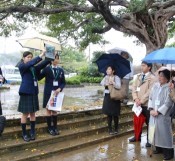
February 3, 2014 Ryukyu Shimpo
On February 2, Okinawa Shogaku High School held a bus tour to retrace the route taken by the Shiraume-tai, a group of Japanese schoolgirls assigned by the Imperial Japanese Army to serve as nurse-aides during the Battle of Okinawa. The students acted as guides.
This year is the 10th year that the students and survivors of the Shiraume-tai have been deepening exchanges.
Listening to the explanation from the students, one of the survivors said, “We can depend on them. I want the students to continue telling the story of our war experiences, and contribute to peace.”
About 50 students and the survivors took part in the tour.
They toured around six sites such as Okinawa Prefectural Daini High School in Naha, the field hospital shelter in Yaese and the Tower of Shiraume in Itoman.
Eighteen first graders took over what their seniors did and acted as guides for the first time.
Soshi Nobu explained that schoolgirls provided round-the-clock care to wounded soldiers in the shelter. He asked, “If you were in the same position, could you endure that hellish work?”
Karin Furiwara, who watched what their juniors did, said, “Although I was worried about them because they read things in a monotone voice, they did their best today. We are the last generation that can hear the war experience stories told by the survivors. I would like to listen closely to what they say while they are alive, and tell their story to the next generation.”
Eighty-five-year-old Ho Takemura, one of the survivors, said, “I feel confident about the students because they have been acting as guides for 10 years. We get older and always feel the need to tell our experiences to the future generations. I would like the students to tell the story to the people around them one by one and contribute to peace.”
Eighty-five-year-old Kiku Nakamura, the head of the survivors’ association said, “I feel confident about what the students are doing because they try to tell our story to other people rather than just listen. Their 10 year-experience makes them well-informed.”
(English translation by T&CT)
Go to Japanese
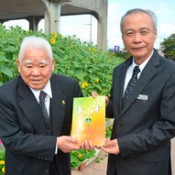
February 6, 2014 Ryukyu Shimpo
An 83-year-old former English teacher from Adaniya, Kitanakagusuku Village, Naohide Higa has self-published a daily conversation book FRIENDSHIP written in English and Shimakutuba, the endangered Okinawan language. On February 3, Higa visited the education board of the village, presenting them with 40 books. Higa also plans to present books to Nakagusuku Village and Nishihara Town.
Higa said, “I wanted to give back what I have received from society.”
As an advisor representative for the main chapter of Karate Goju Ryu Shobukan, he had many opportunities to receive questions about the Okinawan language when he went abroad. Because he could not find a conversation book in English and the Okinawan language, he started planning the project ten years ago. Higa completed the project after four years of writing.
Higa wrote the book both in Shimakutuba and English. He describes daily conversations such as self-introductions and giving directions, also the names of vegetables and fruit, which appear in Okinawan dishes. The book consists of around 100 pages with many example sentences. Higa mostly used the language of Adaniya. He said, “The Adaniya dialect is understood everywhere.” The selling price of the book is 1,300 yen. Higa will present 200 yen of the price to the affected areas of the Great East Japan Earthquake.
For further details, call Higa at 098 (935) 2367.
(English translation by T&CT and Megumi Chibana)
Go to Japanese
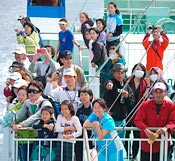
February 5, 2014 Hideaki Yoneda, correspondent of Ryukyu Shimpo
The Executive Committee of the 9th Whales Straits Tokashiki Island Marathon invited about 200 runners and volunteers whale watching from the Ferry Tokashiki on February 2. They sailed from Tokashiki Port at 1:00 p.m. and soon encountered about 20 humpback whales that were swimming between the islands of Zamami and Tonaki. A pod of whales surrounded the ferry. The participants, some holding cameras or binoculars, cheered upon seeing the magnificent spectacle of the huge whales blowing and flicking their tails on the surface of the sea.

Humpback whales show their majestic figures on the southern side of Tokashiki Island on February 2.
The government will designate Kerama Islands, known for their coral reefs, as Japan’s 31st national park on March 5. The runners and volunteers who took part in the Whales Straits Tokashiki Island Marathon enjoyed the charm of the sea in addition to the race. Miyoko Akashi, 52, from Hiroshima Prefecture, who took part in the half marathon, “I enjoyed the race while watching the beautiful sea around the island. I am very happy to see so many whales for the first time.” Junko Gushiken, 52, from Okinawa City, was excited seeing the whales. She said, “I want to tell people what a wonderful marathon and whale tour I experienced on the island.”
(English translation by T&CT)
Go to Japanese
Okinawa Governor Hirokazu Nakima has approved land reclamation work in the Henoko district of Nago in preparation for moving U.S. Marine Corps Air Station Futenma. The Japanese and U.S. government are promoting the relocation plan. However, many Okinawan people continue to oppose the plan to reclaim the precious sea where dugongs live. In addition, many experts in and outside Japan suspect the reclamation work for building the new base will negatively affect the natural environment. If both governments force through the plan, it is likely to draw strong international criticism. With the U.S. Ambassador to Japan Caroline Kennedy visiting Okinawa, the Ryukyu Shimpo revisits the issue of Henoko’s natural environment and the damage that will be caused by the reclamation work.
A vast coral community lies at the bottom of sea off Henoko. Endangered species such as dugongs and sea turtles freely swim in the transparent sea that nurtures natural mozuku and a bed of seaweed feeding dugongs. Okinawa has a natural treasure trove around Henokozaki in Nago and Oura Bay where the U.S. and Japanese governments plan to build a new base.
The Nature Conservation Society of Japan looked into the environmental assessment carried out by the Japanese government for the Henoko landfill. The society reported that the areas around Henokozaki and Oura Bay are waters with much biodiversity. The area stands out among all the Ryukyu islands as a place where many rare and indigenous species live. The natural environment conservation policy of the Okinawa Prefectural Government evaluates the area as Rank 1, which needs serious preservation.
Oura Bay is a deep estuary close to the land. Oura and Teima rivers flowing into the bay have brought nourishment over thousands of years, gradually creating a haven of remarkable biodiversity.
However, in a relatively short time, the reclamation work for building the base will bring a load of earth and sand from outside the island into the fertile sea, spoiling what has long brought great benefits to the people. Ignoring the local people who oppose destroying the environment, nature and life, the U.S. and Japanese governments are forcing through the plan.
Even though the governor approved the landfill, he also fears the reclamation work will negatively influence the environment. The earth and sediment for the landfill will be 21 million cubic meters. This is equal to 70 buildings of the Okinawa Prefectural government main office that is from the second basement to the 14th floor.
The earth and sediment for the landfill brought from outside Okinawa will be 17 million cubic meters. This accounts for 80 percent of the total. Many people think invasive alien species that will be carried in the earth and sand from outside the prefecture will upset the regional ecosystem.
The majority of Okinawan people and many intellectuals outside the prefecture, including high profile US figures, oppose the plan to reclaim the long-prospering and beautiful sea of Henoko and Oura Bay. However, the U.S. and Japanese governments are promoting the plan.
(English translation by T&CT)
Click to PDF file (5.91MB)
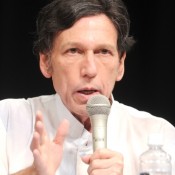
On February 7, 29 internationally prominent intellectuals released a statement that opposes moving U.S. Marine Corps Air Station Futenma to the Henoko district in Nago and seeks the prompt closure and return of the base. The Ryukyu Shimpo introduces their messages to the readers.
Stand tall, fight bravely and know you are not alone
Peter Kuznick
Professor of History, American University,co-author the book and ten part TV series “The Untold History of the United States”.
When Oliver Stone, Satoko Norimatsu, and I visited Okinawa this summer, we met many extraordinary people from all walks of life, who greeted us with kindness and generosity. Among them were several extremely dedicated elected officials. Two who stand out especially vividly in my memory are former Governor Masahide Ota and Nago Mayor Susumu Inamine. All too often, elected officials are people without backbone or principle who will sell out their constituents for power or money for public works as Governor Nakaima just did. But Oliver and I knew right away that Ota-san and Inamine-san were different. They sincerely and passionately cared about the people of Okinawa and they understood that the fight to block the relocation of the Futenma U.S. Marine base to Henoko was being waged not only for the Okinawans but for people committed to social justice everywhere.
I have followed Okinawa developments closely since returning to Washington, DC. Nothing has given me more pleasure than to see Mayor Inamine’s reelection this past weekend. To the global anti-base forces, Mayor Inamine has become the face of all the brave people who have been resisting the encroachment of U.S. military bases everywhere across the planet. The U.S. “empire of bases,” as the late Chalmers Johnson called it—between 700 and 1,000 outside the U.S. and its territories—has enabled the militarization of conflict after conflict for almost 70 years. Many of us believe that a different way of settling disputes must be found. Bombing and invasions haven’t worked. An Okinawa polluted by U.S. bases won’t make either the people of Japan or the people of the United States any safer. In fact, it is likely to have the opposite effect.
My message to the people of Okinawa is to stand tall, fight bravely, and know you are not alone. Your friends outside Japan will continue to do everything we can to spread the word or your heroic struggle. And with leaders like Inamine-san and Ota-san, there remains hope that we will succeed.
Go to Japanese
It’s time, finally, for Washington to listen
John Feffer
Co-director of Foreign Policy In Focus (www.fpif.org) at the Institute for Policy Studies

John Feffer
The news that Susumu Inamine has won reelection as mayor of Nago City is tremendous. Not only does it give a tremendous boost to organizations on both sides of the Pacific that are fighting against the construction of another U.S. military base on Okinawa. It also reaffirms two important principles that underlie this struggle.
The first is that this campaign is one of democratic self-determination. Both the U.S. and Japanese governments have claimed that they will not impose a solution on the Okinawan people. Time and again, the Okinawan people have spoken, at the neighborhood, municipal, and prefectural level. They want the U.S. military presence on the island to shrink, not grow or simply be shifted around. The recent vote in Nago City is only the latest in a series of democratic decisions. If Washington and Tokyo want to continue to claim that they are acting within the structures of a democracy, they must recognize the results of this election.
The second point has to do with money. Often the supporters of military bases will speak of the economic benefits that come with the presence of U.S. soldiers. And it is true that some businesses do benefit from the influx of U.S. dollars.
But not everything is about money. The vast majority of Okinawans have repeatedly said – through opinion polls and in elections – that they value some things more than mere money. Indeed, in these last elections in Nago City, the LDP promised an injection of 50 billion yen into Nago City to induce the votes for pro-base candidate.
Not even this bribe could persuade the majority of voters. This issue is not about money.
The United States has promised to shrink its military footprint on Okinawa. It has promised to respect the democratic wishes of the Okinawans. The Okinawans have spoken once again. It’s time, finally, for Washington to listen.
Go to Japanese
We have been inspired by the people of Nago
Joseph Gerson
Director, Peace & Economic Security Program, American Friends Service Committee

Joseph Gerson
On behalf of the initiators of the statement opposing the construction of the Marine air base at Henoko and solidarity with the Okinawan people, I write to let you know that we have been inspired by and congratulate the people of Nago who successfully resisted militarism and political corruption with the exciting and hope filled reelection of Mayor Inamine.
With Prime Minister Abe, Governor Nakaima, and the U.S. disregarding the will of Nago voters and their vows to move forward with the base construction, persistence will be necessary, and we pledge continued solidarity with those committed to protecting the people and environment of Nago and Okinawa.
Nago voters refused to be bought with cynical offers of development assistance and envelopes stuffed with cash. They held to their life-affirming commitments. No local Japanese community has ever before so courageously resisted Tokyo’s will on an issue of such high priority to the government or the military alliance.
Nago voters have blocked the campaign to reinforce U.S. military colonization of Okinawa for decades to come. It was a victory that will resonate across Okinawa, Japan and communities across Asia and the Pacific, inspiring people to take action to bring a more peaceful and sustainable world into being.
Unfortunately, the struggle is not over. Despite their rhetoric about shared values, Prime Minister Abe and President Obama are contemptuous of democracy as practiced by the people of Nago. Abe was embarrassed that he was unable to deliver on his commitments to the Pentagon and is now moving disregard the election’s outcome. We encourage Okinawans to defend your victory, and we will act in solidarity. This is not the first time that Prime Minister Abe has overreached. In 2007, he worked to impose his nationalist agenda, and his government collapsed as a result.
We are encouraged that our statement encouraged people in a “dark” time, and we remain committed to working in support of the peaceful and democratic people of Nago and Okinawa to ensure that the Henoko base will never be built, that the Futenma base will be closed, and to replace military colonialism with Common and Human Security.
Go to Japanese
Learning about democracy from Oura Bay
Alexis Dudden
Professor of History, University of Connecticut

Alexis Dudden
My son is learning about democracy from Oura Bay. He is 8 years old, and he swam in its delicate waters first when he was 4, and then again when he was 7. He loves climbing on its rocks and catching crabs and making new friends on its beaches. It is not easy for us to come for a swim because we live on the East Coast of the United States, but it is important. It is important because in Oura Bay my son understands that he can play with others even when he doesn’t speak all of their words; he realizes that he and children of his generation everywhere must give voice to animals and ecosystems that cannot save themselves from people; and, most important now he grasps that as an American he has tremendous responsibility to know what happens around the world in his name.
During our last visit in July 2012, we saw the new wall with its towering barbed wire fence separating the Okinawan beach from the American beach. We couldn’t believe our eyes. We couldn’t believe that our taxes had gone to replacing the old wire roll with this awful more permanent structure, and we hear that an even higher and thicker one is planned. Maybe it’s already been built. This ugly structure is an embarrassment to the United States. It makes Oura Bay’s lessons clearer and makes us promise never to stop learning from, teaching about, and fighting for the peaceful present and future of these waters. 頑張りましょう!
Go to Japanese
Dear US ambassador to Japan Caroline Kennedy
We sincerely welcome you to visit Okinawa. Japan and the United States have faced many challenges in negotiating on the areas of foreign, security, defense and economic policy. However, we hope that you as the US ambassador to Japan will exert your ability with exceptional insight and in the spirit of humanism to reconstruct the US-Japan relationship. We want multi-layered and sustainable relations backed up by mutual trust between both peoples, without overemphasis on military. We have a strong desire to share the universal values of freedom, democracy and mutual respect for basic human rights with American people.
Negative examples
During the 68 years since the end of World War II, the United States has been a teacher of democracy for the people of Okinawa both through positive and negative examples. Young people of the time, who had studied in the United States after the war, praised the democracy. Many of their generations were inspired to become ‘militarism boys’ through education. However, after completing their study in the United States inspired by the hope of democracy, they made use of their knowledge and experience to promote higher education and reconstruct Okinawan society. Meanwhile, it was the United States that captured their land from the residents at Isabama and Iejima “by bulldozers and bayonets” to construct the base in the early postwar period. Such conduct violated Article 46 of the Hague Convention stating that private property cannot be confiscated.
Before the war, people lived their lives in the place where U.S. Marine Corps Futenma Air Station is located. There were schools, a village office and agricultural land. We want the ambassador to understand this abnormal history and accept the reality that the U.S. government operates a military base in an area where it drove out civilians.
The governments of Japan and the United States say they will move forward with the plan to relocate the Futenma base to Henoko, Nago, under an agreement reached in 2006. MV-22 Osprey aircraft plagued with a history of serious accidents will station permanently at the new base and fighter aircraft will regularly use it, if it completed.
Okinawan people are concerned that the human rights, life and property of residents living in the northern region, will forever be compromised as they will be exposed to noise pollution and the risk of an accident.
Believed to be the origin of the mermaid legend, Dugongs live in the sea where coral reefs spread, off the Henoko district. The dugong is listed “1A” as critically endangered in Japanese Red List published by the Ministry of Environment. The US ambassador to Japan tweeted recently, commenting that the U.S. government opposes drive hunt fishing. While most readers responded favorably with grateful hearts to you on Twitter in English, there were many dissenting voices tweeting in Japanese that said dolphin fishing is a part of the life and tradition of residents in their community. You expressed that you were deeply concerned by the inhumaneness of drive hunt dolphin killing. Then is it not inhumane to pose a threat to the habitat of the dugongs by destroying their feeding grounds?
Currently, in your nation and many other regions, American organisations are providing shelter and sanctuary for manatees, which are internationally protected members of the Dugong family. The Fish and Wildlife Conservation Commission helps rescue manatees and transports them to rehabilitation facilities in Florida. They have a network of expert organizations, including biologists, to save manatees. The International Union for Conservation of Nature (IUCN) has made recommendations to protect the dugongs of Henoko three times. We hope you will accept the recommendations to save this endangered species.
Open the door to create new friendship
Ryukyu Shimpo wrote an editorial published on November 24, 1963, to mourn the death of your father, the 35th President of the United States John Fitzgerald Kennedy, after he was tragically killed by an assassin’s bullets. It reads: “President Kennedy struggled mightily to resolve both the international and internal issues such as the Cuban Missile Crisis, the Limited Test Ban Treaty and racial discrimination. He showed his ability to take action, determination and contribution to resolve the problems as the greatest leader of our age with passion and wisdom.” The death of the standard-bearer of the New Frontier spirit was a great shock for the people of Okinawa.
With the sense of responsibility coming from your father, would you open the door to create new friendship between the U.S. and Ryukyu, and put an end to the military colonial rule in Okinawa? We hope that your visit to Okinawa will help change the policy and allow the government to abandon the relocation plan to Henoko and to move the Futenma base outside Okinawa.
(English translation by T&CT)
Go to Japanese

January 27, 2014 Fumiaki Jahana reports from Hong Kong
On January 26, Orion Breweries held an event called “Okinawa Day” at the World Trade Center at downtown in Hong Kong. They promoted sales of Okinawa’s local beer, Orion, and introduced traditional arts, tourism and products. It is the first time that Orion Breweries held its own promotion event overseas. Singer Manami, the model featured in an advertising campaign for Orion Southern Star Beer, performed a live concert. Eisa dance also was showcased. Many visitors enjoyed Orion beers and the performances on stage.
Besides holding the Okinawa Day event, Orion Breweries expands advertising to outdoor signage and local magazines. In the wake of this event, Orion Breweries will expand its sales promotion overseas. “We could promote beer from Okinawa to many people in Hong Kong. We would like to explore new business opportunities,” said Yoshio Kadekaru, the president of the Orion Breweries, Ltd.
The company officially has started business in Hong Kong with more than 400 mass merchants and restaurants, including the major local supermarket chain Welcome since spring 2011.
(English translation by T&CT, Hitomi Shinzato)
Go to Japanese

February 5, 2014 Ryukyu Shimpo
Over 2,500 people have been taking part in the breakout game that started from January in Miyako Island. The executive committee of the game has been holding the events every weekend, which makes the island busy.
About half of the ticket buyers come from outside Okinawa.
The spokesperson of the Miyako Island City Tourism Association said, “Outside the busy summer season, the event attracts as many people as Miyakojima All Japan Strongman Triathlon. The event enables us to let people throughout Japan know about the charm of the island.”
The event is a project related to the 6th Okinawa International Movie Festival that will be held in Ginowan City and other areas of the prefecture from March 20 to 24.
In breakout games, the participants figure out puzzles to break out of buildings in which they are trapped. These are popular nationwide. It is the first time the participants break out of the whole island.
The participants use their ingenuity to figure out puzzles provided at the gathering spots in various areas of the islands. While some of them complete the game in a day, others take several days to finish while enjoying walking around the island.
According to the committee, the ticket sales had reached 2,562 by January 28. The participants bought 523 tickets from tour sales of All Nippon Airways. About 80 percent of the participants come from outside Okinawa.
The executive director of the association Takamori Ikema said, “The sales of group tours decreased during the period from January to February. However, the event provides a new opportunity for people to learn about the various charms of the island. I want the event to continue next year too.”
(English translation by T&CT)
Go to Japanese

February 4, 2014 Ryukyu Shimpo
The Nago City Council held an extraordinary session on February 3. It adopted a statement protesting against Okinawa Governor Hirokazu Nakaime approval of the Henoko landfill and seeking the withdrawal of this approval. The city council also adopted a statement protesting against the central government promoting the plan to move U.S. Marine Corps Air Station Futenma to Henoko, Nago, and demanded cancellation of the plan to move the base within Okinawa, and closure and return of the base. Two protest statements were approved by a majority vote.
Governor Nakaima approved the Henoko landfill at the end of last year. The Okinawa Prefectural Assembly adopted the resolution to protest against the governor’s approval of the landfill and demanded his resignation at the beginning of this year. In addition to the prefectural assembly, nine municipal councils, including the Nago City Council, have adopted the protest statement or resolution. The Tokashiki Village Council will pass the statement on February 14, and more municipal councils are scheduled to adopt the statement or resolution at their regular meeting in March. The Okinawa Prefectural Association Chairmen of Town and Village Assemblies, which will be held in the middle of March, will vote on the protest statement in the middle of February. Depending on the result of the vote at the meeting of the association, there is a possibility that the movement of protest against the governor’s approval of the Henoko landfill and demands for him to revoke his decision and reject the Henoko plan will spread further.
In response to Abe’s explanation for reducing the base burden, Nakaima said on December 25, 2013, “It was surprisingly admirable. Representing 1.4 million Okinawa people, I am grateful to you.” In the statement, the Nago City Council criticized the governor severely for not being an appropriate representative of the Okinawan people, because the governor’s remarks did not match the consensus of the Okinawa people at all. It asks the governor to take Susumu Inamine’s re-election, which reflects the will of the people, seriously. Fourteen members of the ruling party of the council proposed the statements jointly. Two members of the Komei Party were in favor of the statements. Nine members of the LDP opposed it.
Mayor Inamine commented, “The protest statement is something very meaningful as the intention of the council on behalf of citizens.”
The statement to protest against the relocation plan within the prefecture and the governor who approved the landfill was adopted at the municipal councils of Kadena, Chatan, Nishihara, Yaese, Yomitan and Nakagusuku. The Kitanakagusuku Village Council has adopted a resolution calling for the resignation of the governor.
(English translation by T&CT)
Go to Japanese
Statement adopted by Nago City Council: Okinawa Governor should withdraw approval of Henoko relocation
February 3, 2014 Ryukyu Shimpo
Statement to protest against Okinawa Governor Hirokazu Nakaima’s approval of the Henoko landfill and ask him to withdraw it
Nago City Council has been asking the prefectural and central governments to close and remove U.S. Marine Corps Air Station Futenma, opposing relocation of the base within the prefecture. The council has also been asking them to move the base outside Okinawa and Japan and cancel stationing the MV-22 Osprey to Okinawa.
The mayors of all 41 municipalities in Okinawa, the head of the Okinawa Prefectural Assembly and the chairmen of the various councils signed a petition asking the U.S. and Japanese governments to abandon the idea of moving the base within the prefecture. They gave it to Prime Minister Shinzo Abe last January.
However, on December 27, 2013, Okinawa Governor Hirokazu Nakaima approved the government’s application for a landfill at Henoko in preparation for moving the base. Before that, Nakaima pledged to move the base outside Okinawa in the gubernatorial election held in 2010.
Following the U.S.-Japan joint statement issued in May 2010, Nakaima said, “I really regret the governments decided the plan to move the base within the prefecture without gaining approval from the prefectural government and local people. It is really difficult to accept the plan.” In the prefectural assembly held in June 2010, Nakaima said, “It is almost impossible to carry out the plan. Okinawa has the choice to reject it.”
In the prefectural assembly in September of the same year, he said, “The government should reconsider the statement. We ask for the base to be moved outside the prefecture.”
In an international symposium held in Washington D.C. in September 2011, Nakaima asserted, “It is reasonable to move the base to other parts of Japan and solve the issue swiftly. The government should reconsider the plan.”
In the prefectural assembly in December 2013, he said, “I intend to ask the Japanese and U.S. governments to move the base outside Okinawa and swiftly return the land used for it. It is realistic to look to move the base outside the prefecture.”
The pledges and statements made by Nakaima on the Henoko issue contradict his approval of the landfill. He needs to explain to Okinawan people about what made him change his mind.
In response to Abe’s explanation for reducing base burden, Nakaima said on December 25, 2013, “It was surprisingly admirable. Representing 1.4 million Okinawa people, I am grateful to you.” This statement does not match the consensus of the Okinawa people at all. The Okinawan people were deeply disappointed by that.
The Nago City Council sees Nakaima as not appropriate to be the representative of the Okinawan people. The governor should admit that he has violated his pledge.
The incumbent, Susumu Inamine, who opposes the plan to move the base to Henoko, won his second term in the Nago mayoral election on January 19. Nago citizens once again showed their intention to oppose the plan.
Taking special notice of this, the governor should withdraw the approval.
In order to protect the lives and properties of Nago citizens, the city council strongly protests against Okinawa Governor Hirokazu Nakaima, who approved the Henoko land fill, and asks him to withdraw the approval.
According to the 99th article of the Local Autonomy Act, the council issues the statement.
On February 3, 2014
Nago City Council of Okinawa Prefecture
To:
Okinawa Governor
(English translation by T&CT)
Go to Japanese
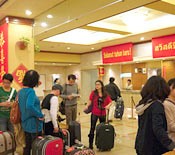
January 31, 2014 Ryukyu Shimpo
Because of the long holiday of the Spring Festival (Chinese New Year) from January 30 to February 6, many tourists from Taiwan and mainland China came to Okinawa. They used international flights between Naha and Taipei, Shanghai and others during the holidays. The airline companies also plan to run many charter flights. Juneyao Airlines of China will launch a new route between Naha and Shanghai from January 31. The number of tourists from mainland China will be greater than last year.
China Airlines, which runs 11 flights a week between Naha and Taipei, saw the flights fully booked until February 1. The rate of reservation after February 2 is also over 80 percent. During the festival, the company will temporarily increase return flights between Naha and Taipei by two and between Ishigaki and Taipei by two.
China Eastern Airlines, which runs a return flight between Naha and Shanghai every day, saw the flights from Shanghai fully booked almost every day until February 3. The company will offer five more return flights during the festival. Juneyao Airlines will start services on the same route. Its reservation rate on the first flight from Shanghai was 83 percent.
Asiana Airlines, which runs flights between Naha and Seoul, saw the rate of booking the flights from Seoul at 83 percent until February 1. The company will offer three return charter flights between Seoul and Miyako.
Hong Kong Airlines saw the reservation rate of the flights from Hong Kong to Okinawa reach around 70 percent until February 2. The Okinawa branch of the company explained, “The Spring Festival holidays in Hong Kong were short this year. That affected the reservation rate.”
Pacific Hotel Okinawa in Naha accepted about 1,200 tourists during the holidays. To create a festive atmosphere, the hotel will set up decorations and play music for the Spring Festival inside the building. In addition, they will hold a countdown event for the Chinese New Year.
(English translation by T&CT and Lima Tokumori)
Go to Japanese












 Webcam(Kokusai Street)
Webcam(Kokusai Street)


